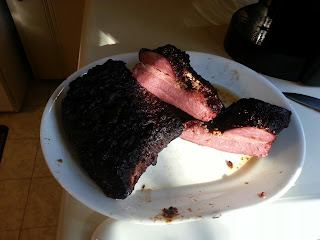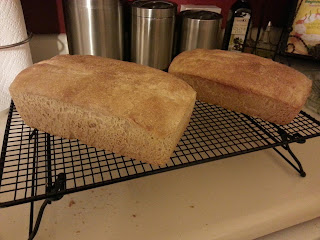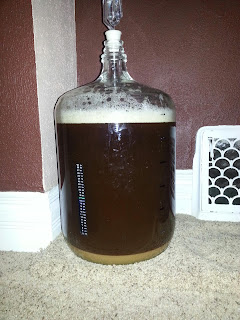Brew days like today are why I love brewing so much. First was the weather, perfect for brewing;
it was 55, sunny, and there was only a light breeze (which the best I can hope
for in IL). Second, I threw almost all
of my tricks into this beer. That made
for a busy schedule throughout the brew, but it was also a lot of fun.
My lagers have not been attenuating as well as I would like,
which was acceptable through the winter when I want some body to my beer. But winter is over, and lighter bodied, easy
drinking, beers are now in order. Today
I brewed a Munich Helles; which is a light colored, malt forward, lager.
In order to push the yeast attenuation up I used a three
step mash. I started the mash with a
protein rest at 125 for 30 minutes. I
kept the mash thick during this stage to make following steps easier.
Thick mash in
I then raised the temp up to a Beta Saccrification rest with
boiling water. This ended up being a 45
minute rest that started at 145 and ended at 140.
Beta rest
At the 30 minute point of the Beta rest I pulled out 5
quarts of solids for a decoction. I have
done decoction mashes in the past, most recently a double decocted Dopplebock,
but never in a beer that was supposed to be so light in color. So I used my normal procedure of slowly
raising the temp of the decoction to boiling, but this time I returned it to
the mash as soon as I achieved a boil; hoping to reduce the maillard reaction.
Decoction
After bringing the temp up to 154, for a low end Alpha
Saccrification rest of 15 minutes, I added more boiling water for my mash out
and it was a normal brew day for a while…
Sparge
Hot break

I was recently listening to an episode of Brew Strong, on
the Brewing Network, where they talked about off flavors produced by trub in
the primary of lighter colored beers (Pilsner and Helles were mentioned
specifically). So I decided to try something totally new for me, and leave as
much of the trub in the boil kettle as I could. To do this I let the wort sit
for 15 minutes after cooling it to allow everything to settle. I then siphoned from the top of the wort into
my primary fermenter, through a screen mesh to aerate and catch any hop debris
that might get through. (Sorry no pics
of that process, I was rolling solo today.)
In the end it looked to me like I left about a quart of trub in the
bottom of the kettle, so I’m expecting to find another quart in the bottom of
my fermenter when I transfer (I normally get about a half gallon). Also of note, I again come in above my expected gravity, about an 85% efficiency. I think I need to start expecting higher mash efficiency when working with lower grain volumes.
Gravity reading

After letting it cool in the lagering freezer for 10 hours, down to 47, I aerated it and pitched the yeast. Once fermentation has started I will slowly bring the temperature up to 50.
Almost forgot the recipe...
9 lbs Pilsener (90%)
0.5 lbs Vienna (5%)
0.5 lbs Munich Type II (5%)
Hallertauer 4.3% AAU (45 min)
Hersbrucker 3.95 AAU (20 min)
Wyeast 2206 (Washed)
Stay tuned in for
future updates.
4/10/2013 - Fermentation had slowed significantly (over 20 seconds between bubbles) so I turned the temperature in my lager freezer up to 60 (and opened the freezer) for the diacetyl rest. It took about 6 hours for the temperature in the freezer to get up to 60 (at least another 6 for the beer to get to that temp). After 48 hours at 60 degrees I will begin turning the freezer down 2 degrees per day until reaching my lagering temperature (40).
5/1/2013 - My lagering technique needs some fine tuning. After a five day diacetyl rest the fermentation was still going strong, so I put it back in the lager tank to finish fermenting at a high primary lager temp, 54*. After fermentation appeared to come to a complete stop, on 4/27/2013, I transferred into a secondary and began lowering to lagering temperature, which I achieved today; 40*. I'm concerned about all the extra time spent at warmer temperatures for what is supposed to be a bright, crisp, and refreshing beer...
















